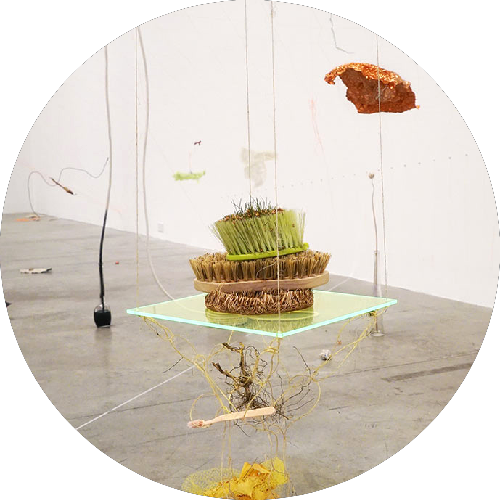A Lively Arrangement
Artist
When I was growing up I spent a lot of time looking through Ikebana by Senei Ikenobō. Ikebana is the Japanese practice of flower arranging, considered one of the Zen arts alongside calligraphy and tea ceremony. Ikebana is a meditative practice and the arranger, through the selection of organic materials, the container or vessel, and arrangement of the components, contemplates nature, the changing seasons and the transience of life. Flipping through my little ikebana book, even today, what I notice is that I’m drawn as much to the pottery as the floral combinations. These two elements coming together—the container and the contained—activates a third, unexpected element. Juxtaposition figures into my everyday thinking and my visual art practice.
Natalie Purschwitz is an artist and designer living and working on the traditional, ancestral and unceded territories of the xʷməθkʷəy̓əm, Sḵwx̱wú7mesh Úxwumixw, and səl̓ilw̓ətaʔɬ First Nations, also known as Vancouver. Her research draws on modes of making that include collecting, accumulating, arranging, editing, and writing. She is curious about the ways that landscapes are shaped by humans and nonhumans, through systems of organization, networks of support, and ruptures within these systems. By reconfiguring everyday objects and elemental substances, Purschwitz creates conditions for material events. Natalie grew up in a small town in the Canadian Rockies.
Natalie Purschwitz
Tend to your objects every day. Arrange and rearrange, remove and replace.
Invitation
Gather the following: one vessel or container, a natural element, a synthetic or plastic element, an object of value (personal), a bit of string, twine, wool, or thread, a few bits of paper, one living thing that requires tending (a cutting of a plant, or a bunch of fresh-cut flowers), and an object that makes you laugh to yourself.
Create a space for these objects on a desk or table or shelf where you will have easy access every day for one week. Keep a notebook nearby.
Tend to your objects every day. Arrange & rearrange. Remove and replace items if you feel compelled to do so. In the notebook, record the changes you make, and your observations: associations that arise as you touch the objects, feelings, observations, sensory descriptions. Dedicate at least 20 minutes a day to tending to your arrangement.
At the end of the week, you should have a hearty mix of gestures and movements as well as a list of sensory details. Tend to your notes just as you did your objects, moving words and lines around. Are the living elements thriving? Are there interesting juxtapositions you haven't tried yet? Is there an element that needs replacing? Is there an element that was removed that needs to return to the arrangement? Play with the language you generated until you settle on a lively arrangement.
Give your arrangement a title and give it away.
